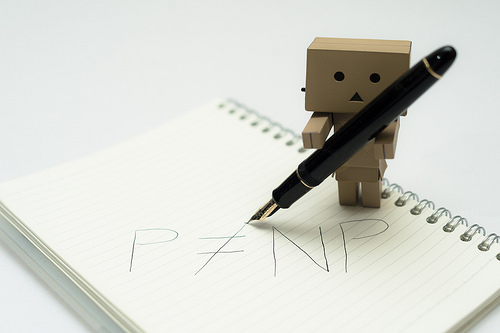Happy Pi Day – P versus NP by Takashi
v
Pi Day
* * *
by Mark Levy
* * *
A physicist named Larry Shaw worked at San Francisco’s Exploratorium and became enamored with pi. For those of you who may have slept through part of the seventh grade, the ratio of a circle’s circumference to its diameter is a number called pi (p-i) or the Greek symbol π. If you know a circle’s diameter, you can easily calculate its circumference. This information is sure to come in handy when you want to impress a mathematician at a party.
The number is irrational, like some mathematicians, in fact, so the decimal places never end and never repeat. Pi can’t be represented as a ratio of integers, so don’t even try it. Trust me. It’s also a transcendental number because it can’t be produced by a finite series of calculations.
The value of pi starts with 3.14. Remember that figure, 3.14, because I’ll mention it later.
Dr. Shaw looks a bit like a mischievous Santa Claus with a perpetual smile, a full white beard, and a LOT of unkempt hair. You can see his photograph by googling him. He was so interested in the number pi, in fact, he created a special day to celebrate pi and called it Pi Day (or Pi Dī, if you happen to be visiting from Australia). Pi Day is a lot easier to enunciate than Circumference-to-Diameter-Ratio Day. Although Larry Shaw retired, the Exploratorium continues to host an annual celebration now at Pier 15 in San Francisco.
The first Pi Day was March 14, 1988. March 14th. 3/14. Get it? So far, so good. Coincidentally, March 14th also happens to be Albert Einstein’s birthday, which meets my quota of trivia for this essay. You can find other people born on March 14th or, for that matter, on any day, including your birthday, by checking famousbirthdays.com. If you happen to be in Princeton, New Jersey on Einstein’s birthday, feel free to enter the annual Einstein look-alike contest.
Now back to pi. Since 1988, more and more people have celebrated Pi Day and in 2009, the U.S. House of Representatives officially designated March 14th National Pi Day. The Admissions Department of M.I.T., the Massachusetts Institute of Technology, mails its decision letters to students so they are delivered on Pi Day. Oops, now I’ve done it: I’ve just exceeded my trivia quota.
If you divide 22 by 7 you get a reasonable approximation of pi. So someone decided to name 22/7, that is, July 22nd, Pi Approximation Day. That way, obsessed math students could celebrate two days each year.
People in San Francisco observe the day by dressing up in appropriate, usually gaudy clothing and flashy jewelry, marching around in a Pi Procession, eating all sorts of pies, of course, and conducting discussions, presentations, and demonstrations. One year, Albert Einstein in puppet form sang a rap about pi. Sometimes people toss pies and pizza dough at each other. Some people recite pi to as many decimal places as they can remember, but none of the participants comes close to Akira Haraguchi, the world record-holder who recited more than 83,000 decimal places for pi. I have to admit that’s pretty impressive to me, who can’t even remember my cholesterol numbers.
This March 14th, 2015 is especially significant, because the first ten digits of pi are represented sequentially as the date and time: 3/14/15 at 9:26:53 a.m. (Or p.m. if you want to sleep in that Saturday.)
The history of pi is interesting, even if you aren’t a mathematician. Egyptians were able to approximate it way back in the 26th century B.C. and mathematicians have improved on the accuracy ever since. Through the years, Archimedes, Isaac Newton, and a host of amateurs have taken a shot at calculating a better, more accurate value of pi. It wasn’t until 1748 A.D. that Leonhard Euler used the Greek letter to represent pi. And about 150 years later, in 1897, the Indiana legislature, bless them, came close to passing a law declaring pi exactly equal to 3.2. But smarter heads prevailed.
Starting in 1949, computers were enlisted to fight the battle of the precise value of pi and things really took off. The number of decimal places of pi started at 2,000 and reached 100,000 only 12 years later. They reached 100 million in 1987. A few web sites include the first million decimal places for pi. Here’s an easy web site to remember to see all million numbers: www.EveAndersson(withtwo s’s).com/pi.
The 1990s witnessed computers displaying a billion, tens of billions, and even hundreds of billions of decimal places for pi. Recently home computers were used to calculate pi to 14 trillion decimal places, rivaling our national debt. What am I saying? Our national debt is trillions of dollars greater, now more than $17 trillion.
All of these lofty numbers make me dizzy. That’s just one of the reasons I’ll never aspire to the job of Secretary of the Treasury. I think I’ll take a nap right after I warm up an apple or blueberry… MUFFIN!
About the author:


Recent Comments